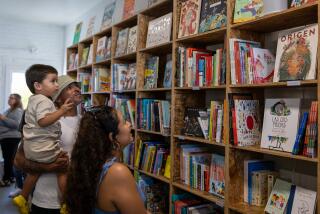New library is a magnet at Fuller Theological Seminary
- Share via
Noel Snyder, who is studying at Fuller Theological Seminary to be a Presbyterian minister, was doing homework in a cozy, light-filled second-floor nook of the Pasadena school’s new library. It’s a great place to read, he said, and nearby are shelf after shelf of the books he needs to research potential sermons.
“I used to study at home, but now it’s easier to concentrate and focus here,” said Snyder, 28, a Michigan native. And because the modern facility, with its outdoor balconies, comfortable furniture and computer labs, has quickly become a magnet for students, studying there also makes it easier to stay in contact with classmates, he added.
Formally dedicated last week, Fuller’s new library is a big improvement for the multi-denominational graduate school and seminary, which offers master’s and doctorate degrees in theology, psychology and intercultural studies. About 1,800 full- and part-time students are enrolled at its main campus near Pasadena City Hall, and about 2,000 others attend six satellite centers nationwide and online.
Combined with the renovated building that housed an older library next door, the $28.5-million project now has double the floor space and triple the room for books. That will allow its current collection of 525,000 volumes and compact discs plenty of room to grow; eventually, more than 300,000 other books owned by Fuller and stored around the country will be shipped to Pasadena.
“The old building was inadequate for a library moving into the future. So something had to be done and it had to be drastic,” said David Bundy, the school’s associate provost for library services, who offered a visitor a tour with the pride and enthusiasm of a new father showing off his baby.
Named after former Fuller President David Allan Hubbard, who led the school for 30 years until 1993, the new library contains treasures from the past and present. Its holdings, kept in three stories of public space and two underground storage levels, include hymnals dating to the 1600s and the personal papers of M. Scott Peck, the psychiatrist and Christian author of “The Road Less Traveled,” who died in 2005.
One of Fuller’s most popular and fastest-growing collections is in Asian studies, reflecting the school’s large number of Asian and Asian American students. The Hubbard library has about 25,000 theological books written in Chinese, Japanese, Korean and Vietnamese. Browsers can find a 1987 dissertation about lay leadership in Korean churches, a 2004 architectural history of Vietnamese Catholic churches and a series of theology journals in Japanese.
“People come from all over the Pacific Rim to use this collection and our English-language collections too,” Bundy said. “The goal of this is to help these newer churches find their connections to the rest of the Christian tradition. To understand themselves better, they have to understand this dialogue between where they are and where they came from.”
Daniel Ra, who is studying for a master’s degree in divinity and plans to be ordained in the Evangelical Covenant Church, said the collection helps his research about the Asian American religious experience. “As students, we are grappling with being American and Asian and how to be part of an immigrant church,” said Ra, 28, whose Korean American immigrant family lives in Downey.
Beyond providing better access to books, the library has improved social interaction on campus with its group study rooms, Ra said. “Obviously, it’s a library and has a sense of hush and reverence, but it has spaces where you can engage with other students. It gives people the oxygen to converse.”
Financed with donations, the Hubbard library was designed by William McDonough and Partners, an architecture firm well-known for its emphasis on green construction. The building contains many recycled materials and is intended to be energy- and water-efficient. That reflects Fuller’s theological emphasis on good stewardship of the world’s resources, officials said.
Its contemporary look, in concrete, glass, wood and metal, contrasts with the 100-year-old Craftsman-style houses that serve as offices on Fuller’s pedestrian-friendly campus.
From the library’s third-floor balcony and the large windows in its reading rooms, visitors have good views of the surrounding streets and nearby landmarks such as the City Hall dome. Administrators say that is intended to ensure that students don’t ignore the world just outside the door. “We think it’s a great porthole to the city of Pasadena and an asset to the city of Pasadena,” Howard Wilson, Fuller’s executive vice president for administration, said of the library design.
Even in the digital age, when significant scholarship can be done online, religious studies retain a strong connection to printed books, Wilson said. “Theology, among all the academic disciplines, is still paper-based,” he said.
Still, the Hubbard library makes many concessions to the Internet age -- including the electrical outlets where laptops can be plugged in.
Compared to the old library, “just having access to a plug is a huge difference,” said Snyder, the divinity student from Michigan. “We used to compete over who got to plug into the extension cord. It might seem funny about seminarians competing. But that’s what happened.”
--
More to Read
Sign up for Essential California
The most important California stories and recommendations in your inbox every morning.
You may occasionally receive promotional content from the Los Angeles Times.














